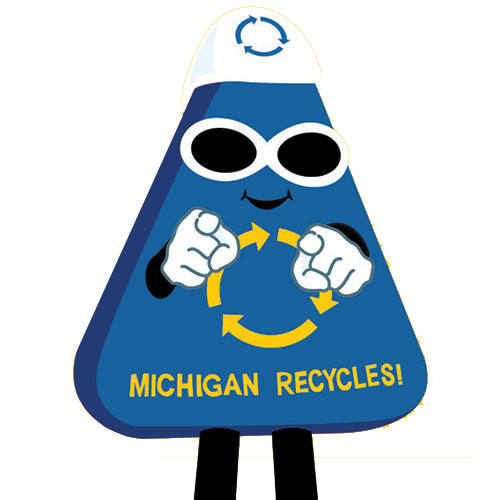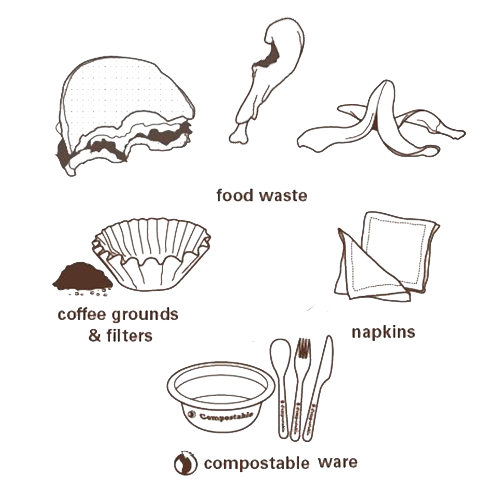
General Sustainability Questions
Thanks for your interest! Check out the Planet Blue Campus Get Involved page for opportunities ranging from student groups to workplace initiatives to becoming a Planet Blue Ambassador. Reach out to [email protected] if you have further questions.
We’re glad you enjoyed your Planet Blue water bottle! And we’re sorry it’s lost or broken, but supplies have run out so we aren’t able to replace it.
As of 2022, there are more than 400 water bottle fillers on campus, which have proven very popular. They have helped people migrate away from single-use bottled water—reducing waste, saving money, and promoting healthy habits.
As of winter 2023, efforts are underway to update the inventory of existing bottle refill stations and develop a plan to fill the gaps. U-M leadership is committed to ensuring every building on campus has access.
If you have identified a spot where a refill station may be needed, or there’s a problem with an existing refill station, contact the building facility manager. (Let us know if you need help identifying who to reach out to.)
All chemical, radioactive, biological, and universal waste (batteries, light bulbs, ballasts, and e-waste) must be collected by EHS Hazmat. Call (734)-763-4568 for assistance.
Based on life cycle analysis, electric hand dryers have lower carbon dioxide emissions (and lower cost) than paper towel dispensers. At U-M, the decision to install hand dryers or paper towel dispensers should take into account the type of building occupancy and function, the preference of the building management, input from Custodial Services and Maintenance perspectives, and the associated costs and environmental impact. If installing a paper towel dispenser, a controlled-release dispenser is more sustainable than multi-fold towels or towels dispensed by user-controlled lever.

Waste Reduction
Look up specific items in our Where to Throw tool. If we haven’t answered your question there, email [email protected] and we’ll help you out!
For recycling and landfill bins, submit a work order via the Facilities Service Center. For compost bins, email [email protected]. For more information, check out our Waste Bins page.
Recycling and composting options vary by location. Please email [email protected] with your specific location information.
Unfortunately we are unable to provide compost or other waste hauling services to off-campus/ non-university-owned buildings, as operational funding is limited to campus-owned property. Additionally, our Waste Management Services team is working at full-capacity to support and expand on-campus compost collection. In addition to these limitations, our equipment is not aligned to service curbside carts, nor are they insured to operate in off-campus collection.
No. Unfortunately, our operational funding does not allow us to handle waste generated off campus. Additionally, our Waste Management Services team is working at full-capacity to support existing on-campus compost collection. We encourage you to reach out to your landlord, municipality and/or waste hauler to express your interest in compost service.
If you live in Ann Arbor, we recommend calling the City of Ann Arbor Solid Waste Que for Customer Service (734-994-7336) and indicating you are requesting compost service for a multi-family location. This will place the request through the official approval process. Note: if the compost cart can be placed/picked up from the curb as is done with other residential areas, and is along an existing route, the addition is more likely to be accepted.
Also, this video from Sustainable Living Experience students will show you how to get a City of Ann Arbor compost bin (if you live off-campus in Ann Arbor) and make a DIY compost bucket for use at home.
Unfortunately, the university’s recycling facility partner, Western Washtenaw Recycling Authority, no longer accepts glass for recycling. The market for glass is very poor, with no manufacturer who wants to purchase old glass to make something new. This is why it is so important for all of us to purchase items that contain recycled content. When people buy recycled-content items, there is an incentive for companies to use recycled content in their products. As the demand for recycled content increases, recycling facilities are able to not only sell the material they collect, but can often also make enough money to reduce what customers (like U-M) have to pay for the recycling service.
If you are interested in scheduling a tour of the Western Washtenaw Recycling Authority MRF, please email [email protected] at least four weeks in advance of your requested date.
Contact U-M Property Disposition. If you have usable equipment, chemicals, or other lab materials that you no longer need, considering donating them to the Lab Reuse Program.
U-M is no longer hosting e-waste recycling events. Until 2016, the Office of Campus Sustainability was partnering with an external tech company to host and promote the event. However, that company has since had a change in direction in how they handle recycling. Also, year-round e-waste recycling is now more available from cities and counties.
Here are some options!
- Washtenaw County residents can take advantage of countywide cleanup days.
- Washtenaw resources for electronics reuse and recycling
- Ann Arbor resources for electronic waste recycling
For tips on recycling your e-waste at other times or other places, see the EPA website.
Please note that if you’re trying to dispose of U-M electronics, they should be sent to Property Disposition. End-of-life electronics are either wiped and resold or are recycled as “universal waste” through a contract with a Michigan recycling company.
Unfortunately, we are unable to support zero waste events off-campus, but if you need advice, we are happy to offer some pointers. Email [email protected].
Composting is the natural process by which organic materials (e.g. food waste, yard waste, plants, etc.) decompose into a nutrient-rich soil amendment known as compost. The difference between composting and natural decomposition is that composting is purposefully managed. A banana peel thrown on the ground will decompose, but will not create compost. However, the same peel placed with other organic material in a pile will break down into compost.
There are three common types of composting:
Aerobic composting: This is the type of composting that occurs in backyard compost piles, other outdoor composting operations and certain enclosed composting systems (often called “in-vessel composters”). Organic matter is broken down by bacteria naturally found in the soil. The term “aerobic” means that this process requires oxygen (just like aerobic exercise!). Specifically, the bacteria that decompose the material require oxygen to do their job.
Aerobic compost piles must be occasionally turned or stirred up to ensure that the bacteria are getting the oxygen that they need to break down the organics without producing bad odors. If an aerobic composting operation isn’t managed properly, the compost pile will “go anaerobic,” begin creating methane and STINK!
Anaerobic composting: This is the type of composting that occurs in enclosed composting systems called “digesters” or “anaerobic digesters.” Organic matter is broken down by anaerobic bacteria, meaning that the bacteria work without oxygen. These systems are kept enclosed for two reasons: the presence of oxygen can be better managed indoors and one of the byproducts of this process is methane, an odorous gas. While anaerobic composting smells terrible, the methane can be used as a fuel source.
Vermicomposting: This is a type of aerobic composting that relies heavily on worms (instead of just bacteria) to break down the organic matter. One of the benefits of this system is that it can be done indoors. “Vermi” is Latin for “worm” and a vented bin with some shredded paper, food waste and worms is all that is required to begin a vermicomposting system.
No. Here’s a great video explanation of the difference between compostable and biodegradable.
Well, biodegradable is still good for the earth because these items break down in a landfill, right? That’s what the vendor told me…
Nope! Landfills are designed to prevent items from breaking down.
U-M partners with Spurt Industries, a composting facility in Wixom. U-M’s Waste Management team collects compost from loading docks and stores it in roll-off dumpsters on North Campus. Spurt Industries collects the dumpsters once they are full to minimize transportation emissions.
In a few other locations, we have additional partners. Food waste from University Hospital and Mott Women’s and Children’s Hospitals patient meals and pre-consumer waste in their vendor kitchens are collected by My Green Michigan. Compostable waste collected from the stadium on game days goes to WeCare Denali in Ann Arbor or to our own Matthaei Botanical Gardens.
When our compost arrives at each compost facility, it is mixed with yard waste and formed into long piles, known as windrows, where air can circulate and aid in the aerobic decomposition process. After the material has fully decomposed, the finished compost is tested to assess its potential as a fertilizer or soil amendment.
Composted food waste does not typically come back to campus. The majority of our compost needs are served by the compost generated from U-M yard waste at our Grounds facility.
Contamination is the primary reason all food waste is yet to be collected for composting on campus. Contamination is a HUGE concern when it comes to the composting process. While many assume that diverting waste to compost is just like recycling, it couldn’t be farther from the truth.
Here at U-M, we send our mixed recyclables to a Materials Recovery Facility (MRF) where they are sorted, baled and sold. It’s important to keep non-recyclables out because they damage the machines and can reduce the quality of a batch enough that it may have to be landfilled, but sorting does help with some contamination.
Compostables, however, are not sorted. Since compost sites typically deal with yard waste, there hasn’t been a need to sort the incoming material. As a result, any non-compostable items mixed in remain that way through the composting process and result in compost with bits of trash in it. No one wants to buy compost with trash in it to put on their crops, garden, etc. As a result, we need to ensure that there is no contamination in the food waste we send to the compost site.
Collecting contaminant-free (“clean”) compostables is relatively simple in places like prep kitchens, dining halls and catering operations where trained staff are the ones deciding where the waste should go. In areas where the campus community is generating compostables, like coffee shops, cafes, and events, avoiding contamination becomes much more difficult.

Energy
Energy use for the Ann Arbor campus is displayed on the Energy & Emissions page of the Ann Arbor Campus Sustainability dashboard. You can also find this info and much more in the annual reports published by Utilities.
We are currently working to upgrade lighting systems across campus. For many years, we felt that the technology in LED products on the market was not sufficient for our needs. Longevity, compatibility, and consistency were our largest concerns. The industry has developed and we now feel confident in the available lighting solutions. And with the launch of the revolving energy fund, significant funding is now available to speed up this transition.
Having windows open is almost always less efficient than the HVAC. The university HVAC systems filter, dehumidify, and temper outside air provided to the building spaces. Opening the window allows unconditioned outside air in and can work against the HVAC. Even if the temperature outside feels right, it still needs to be filtered and/or dehumidified, causing the HVAC system to work harder to compensate. An open window can also allow pests like insects and mice into the building.
If your space feels uncomfortable and is not maintaining the room thermostat setpoint (plus or minus more than 2 degrees), the HVAC system may need repair. Notify your facility manager or contact Facilities Service Center (734-647-2059 or [email protected]) to have the issue addressed.
Lighting occupancy sensors are great at acting as our steward when we forget to turn off the lights. However, it is best to turn off the lights yourself. Otherwise they will stay on for 20-30 minutes after everyone leaves.
Some lighting controls have an auto-on feature as a convenience. You may wonder: will turning off the light screw up the auto-on feature when someone reenters the room? The worst that can happen is that turning off the light temporarily disables auto-on. The next occupant would need to switch on the light manually, which re-enables the auto-on feature. When in doubt, turn the light out!
Occupancy sensors use infrared and/or ultrasonic sensors to detect whether someone is present. If the sensor’s field of view is not calibrated to cover the entire space, the sensor may not register that someone is in the space and will therefore turn off the lights. The sensor may have failed or may need to be calibrated. If you experience a problem with your lighting controls, please notify your facility manager or contact Facilities Service Center at 734-647-2059 or requests.fo.umich.edu to have the issue addressed.
Room-level HVAC controls continuously operate to maintain the room thermostat setpoint. The system controls do not look at the difference between room temperature and thermostat setpoint. Instead, the system controls operate in two modes: setpoint satisfied or setpoint not satisfied. When the system setpoint is not satisfied, the controls modulate to add more cold air or warm air to drive the room toward the setpoint. The system will continue to modulate until the setpoint is reached.
Setting the thermostat really high or really low typically results in the room overshooting the desired temperature. It is recommended that room thermostats be set between 68°F and 76°F. When a room feels uncomfortable, adjust the thermostat in small (1° or 2°) increments.
Your home furnace operates intermittently and turns on when the temperature in the home is a degree or two away from its thermostat dial setpoint. The furnace operates in either heating or cooling mode to satisfy the home’s thermostat setpoint.
The Heating Ventilation and Air Conditioning (HVAC) system at the university operates continuously, providing filtered, dehumidified, and tempered air (typically near 55°F) to building spaces. Then, the individual room thermostat operates to modulate the amount of air and any additional heat that maybe required to maintain the room thermostat setpoint (typically near 72°F).
You can use blinds to keep your space more comfortable and conserve energy. In the summer, completely lower the blinds then adjust the slats to allow for the desired amount of natural light. The more the blinds are closed, the better they are at reducing the solar heat gain because they reflect some of the solar radiation (heat) away from the room.
In the winter, open the blinds on southern facing windows to allow the solar radiation to enter the space, helping to keep the space warm. When the sun is down, keeping the blinds closed creates an extra barrier that helps keep heat in. To retain even more heat, close curtains or drapes in the winter.
Learn more at energy.gov/energysaver/energy-efficient-window-treatments.
Fume hoods continually exhaust room air to remove any hazardous chemicals from the hood, keeping occupants safe. To maintain the proper room pressurization, outside air is conditioned (filtered, dehumidified, cooled or heated) and continually supplied to the entire space to offset the air that is being exhausted by fume hoods. The continuous exchange of air is energy intensive because the HVAC system must run continuously.
Most fume hoods exhaust more air when the sash is fully open, which means the room requires more conditioned air to offset the exhaust. Therefore, keeping the fume hood sash closed when not in use reduces energy use.
Note: energy use varies by fume hood type. Bypass fume hoods consume energy at a near-constant rate, regardless of sash position. Even though closing the sash on a bypass hood doesn’t save energy, for safety it’s always wise to keep the sash closed when not in use.


